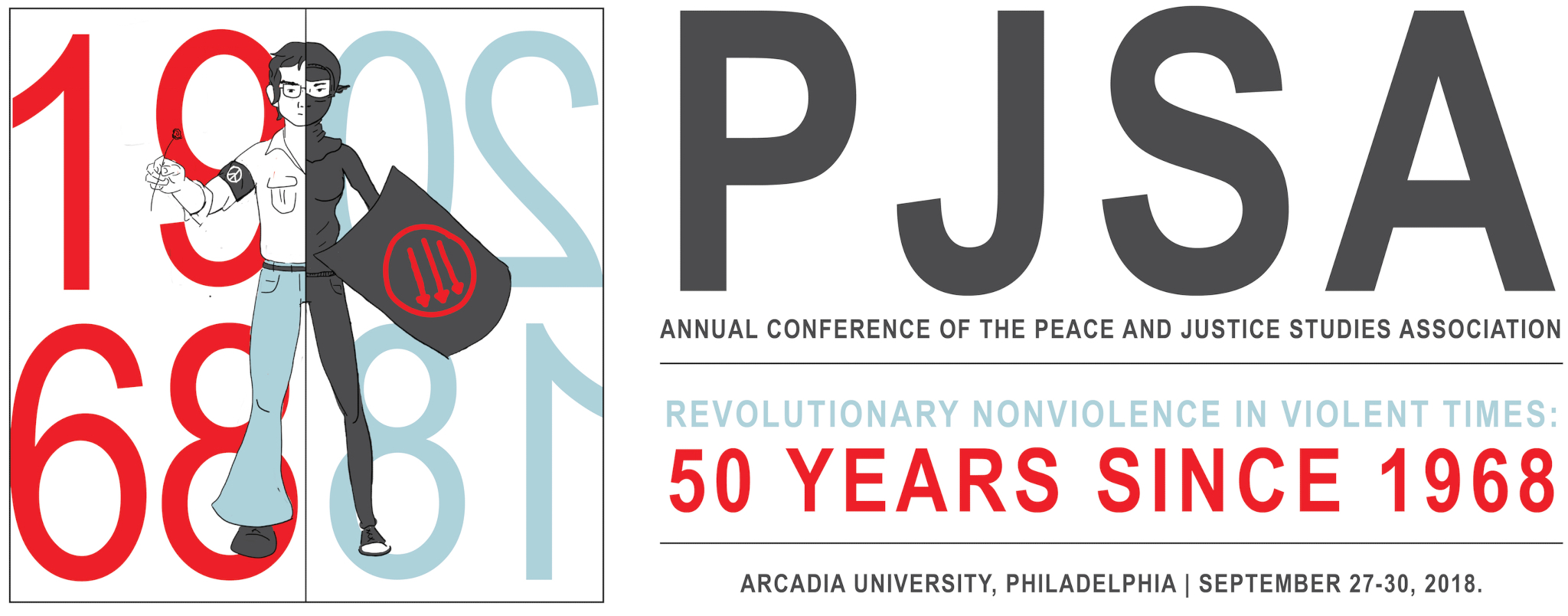Revolutionary Nonviolence in Violent Times
Annual conference of the Peace & Justice Studies Association
September 28-30, 2018, Arcadia University, Philadelphia, PA
Violence in North America is endemic; its institutionalized — structural, physical, psychological spiritual and emotional — through the prison industrial complex, the military and police forces, proliferation of gun violence, poverty, racism, sexism, and some would argue capitalism itself. With the growth of hate groups in the US and Canada, increasing acts of violence against marginalized communities both by states and individuals, and a widening income gap, violence appears to be intensifying both locally and globally. Clashes abound with increasingly visible movements advocating for white supremacy, a growing frequency of violent interactions at political demonstrations, and recurrent debates between notions of ‘free speech’ and community self-defense. The current administration has demonstrated its failure to condemn violence by neo-Nazis and other racist forces while criminalizing acts which have historically been considered protected forms of political expression.
Yet, none of this is new. Fifty years ago, 1968, was a worldwide year of protest and revolution. Civil Rights movements in the US and Northern Ireland, student movements, anti-Vietnam war protests and anti-oppression struggles spread across the globe from France, Northern Ireland, Spain, to Italy, Mexico, Brazil, Germany, and England. In the US, there were New York and Florida teachers’ strikes, sanitation strikes in St. Petersburg, Florida and Memphis, and the growth of the Delano grape strike in California to name a few. This was contrasted with the violent assassination of Dr. King, and accompanying riots in Baltimore, Chicago, Cincinnati, Detroit, Kansas City, Louisville, New York, Pittsburgh, Washington, Wilmington, and elsewhere. The Chinese Cultural Revolution was underway, and South Africa reaffirmed its commitment to a violent Apartheid state. Wars raged in Angola, Guinea-Bissau, Eritrea, Mozambique, Rhodesia, Yemen, Oman, Portugal, Korea and Malaysia, as well as recent coups in Guatemala Panama, Peru, Mali, the Republic of the Congo, Sierra Leone, and Iraq.
Both today and fifty years ago, violence and nonviolence were used as tactics as well as strategies. One might argue progress towards peace evades us. It isn’t particularly clear how to bring about sustainable change and progress. Are our notions and definitions of what constitutes violence and nonviolence oversimplified? What exactly has changed, if anything? What does revolutionary nonviolence, pacifism, and militancy look like then compared to now? How do we understand these terms and definitions today? How is revolutionary nonviolence expressed, practiced or utilized in this current political environment? What lessons and ideas still resonate? From the passive to the coercive, and from the Gandhian to the guerrilla, what are effective means of struggle today, and how are they different from the past?
As peace scholars, practitioners, teachers, and activists, we are interested in hearing reflections, critical engagements, and historical analyses about these and related themes, especially those which consider the following three central areas:
Systemic and Historical Visions of the Nonviolence-Violence Continuum
- How can revolutionary nonviolence be a framework for creating peace, and challenging structural, cultural, and direct forms of violence, while also growing and diversifying our movements?
- How has the government, police, and other State forces served to redefine the violence/nonviolence continuum? What are the legal challenges, precedents and cases which are defining and redefining nonviolence as they pertain to social movements, activism and those engaged with creating peace and change?
- What lessons can we draw from the movements against the War in Vietnam, struggles against South African Apartheid, and those countering austerity, and other structural inequities?
Creating the Beloved Community: Solidarity and Engagement
- Have have our notions of solidarity, charity, saviorism and internationalism changed?
- What is the relationship between nonviolent civil disobedience and community self-defense? Community solidarity? Does this definition serve to empower or silence our broader community of changemakers?
- How might we challenge the easy equation of active pacifism with passive endurance? Is it possible to be a pacifist and an activist? What does that look like? Sound like?
- How can revolutionary nonviolence serve as a challenge to structural inequalities and not simply episodic resistance?
- How can we create King’s ‘beloved community’ in our homes, in our movements, and in our collective actions?
Violence and Nonviolence in ‘Our’ Communities
- What can educators, scholars, activists and practitioners dedicated to the study of peace and the ending of violence do to engage today, tomorrow and into the future? How and where might such engagements unfold?
- Who are our partners in peacebuilding?
- How do we engage self-reflectively with the systemic violence — cultural, spiritual, psychological, and, emotional — embedded in peacebuilding organizations and communities? Or, to paraphrase Christian scripture, why do we look at the speck of sawdust in the others’ eyes without acknowledging the log(s) in our own?
Debate around defining nonviolence has typically been mired in a distinction between the likes of Gandhi and Gene Sharp, and those advocating something else. If the mainstream media insists on championing a false dichotomy between passive liberalism and active, militant, opposition, we need to be on the forefront challenging this narrative. We know it has never been as simple as choosing between ‘Martin and Malcolm’, but rather placing oneself on an ever-expanding continuum from ‘violence’ to ‘nonviolence’. It is time that we work to undo this simplistic frame, and to clarify what we mean when we say nonviolence today. If the field of Peace Studies fails to establish itself as both an advocate for change and a voice worthy of being heard, we risk relegating ourselves to irrelevance. This is a call for us to be engaged in the debates ongoing today in our classrooms, in the media, and in the streets, and to ask the challenging question: what is revolutionary nonviolence in 2018, 50 years after 1968?


